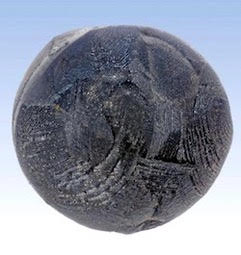
Like a lot of great stories, Jon Larsen’s life-changer began in a moment so mundane, most of us would have forgotten it. Before breakfast one morning, Larsen wiped down the table til it was spotless, then turned back a second later to see a spot, “a shiny little speck that hadn’t been there before.”
“I could feel it was not smooth, it was a little bit angular,” Larsen said. “And I thought, could this be a bit of stardust?”
Spoiler alert: It could, and it was.
Eight years later, science is celebrating Larsen for collecting and identifying micrometeorites, microscopic flecks of grit that permeate his kitchen table, our solar system, and beyond. Kudos are pouring in from the art world too, because, with the help of a photographer, Larsen figured out a way to take and enlarge images of his micrometeorites, photos now appearing in his new book, In Search of Stardust (Voyageur Press).
The best part? Larsen is not a scientist by trade. He’s a Norwegian jazz guitarist.
Larsen’s acclaim didn’t come easy. He spent hour upon grubby hour on his hands and knees scouring city rooftops for dirt. Because, he reasoned, high, flat rooftops were just the right receptacle for the detritus of the cosmos to settle and collect.
Larsen scraped up all the soot and soil and, let’s face it, probably a meteorite worth of pigeon poop, sifted it with a magnet, and studied the magnetic bits under a microscope. He catalogued everything that could be identified as terrestrial, that is, from Earth, figuring what was left would have to be extra-terrestrial. Star dust.
“We think of science as doing big, sexy things, making big sexy discoveries, and it is,” Jolene Creighton, editor-in-chief of Futurism, said during a panel talk with Larsen at NYC’s Agora Gallery. “But it’s preceded by years and years of hard work. And that is science.”
That’s writing, too, isn’t it? You spend years up to your elbows in dirt, looking for the one speck that shimmers above all the rest.
And it starts with an idea that’s just a little out there. Larsen’s soared into his mind like a comet, and it would have been easy, understandable even, to just let it zoom right on by. Space dust on my breakfast table? Uh, no.
Larsen, however, said, Sure, why not? “We tend to think that everything is invented already, everything is discovered,” Larsen said. “That’s not true. There is so much yet to be discovered.”
To get there, though, you need faith, not only in that strange, sparkly idea. You must also have faith in the discovery yet to be made, the one that can only be made by you.

Kelly Caldwell
Dean of Faculty


